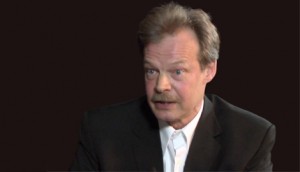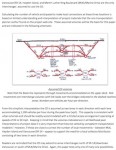In light of the U.S. Department of Transportation’s “record of decision” approving the final environmental impact statement (FEIS) of the Columbia River Crossing Light Rail project, COUV.COM revisits a Clark County Today interview with world-renowned designer and architect Kevin Peterson.

Architect Kevin Peterson recommends straigthening the curve in the current CRC light rail bridge design.
The CRC is an ambitious bridge, highway, and light rail project that would require more than $1 billion in federal highway and transit funds, $1 billion in tolls, and $900 million in funding from Oregon and Washington. Alternative bridge designs may still be considered, since final approval to fund the current CRC version requires unanimous approval from the Washington and Oregon state legislatures, as well as the governors.
Peterson is a specialist in conceptual and preliminary design of urban, transportation facility and infrastructure improvements. His experience is extensive, ranging from planning new cities to small unusual transit improvements, and he has contributed to hundreds of transportation projects around the globe. He came into the process over a year ago when designers in Portland asked him to review the CRC design.
What quickly became obvious to him was that the Oregon Department of Transportation (ODOT) and the Washington State Department of Transportation (WSDOT) failed to come up with a viable design to handle the complexity of the project. Instead the CRC put forward an expensive solution that leaves a large freeway footprint, obtrusive freeway noise, and does substantial harm to downtown Vancouver and Hayden Island.
“I would not want what is currently being proposed in my city,” said Peterson.
Collector-distributor method straightens proposed CRC design
A major factor for this failure was that the CRC’s initial planning constraints hampered designers in delivering the best solution. In analyzing the CRC design, Peterson identified mistakes the designers made early on, among them an incorrect FAA glide slope criteria, ultimately forcing the designers to choose a single-level one-size-fits-all freeway with too many huge and closely spaced interchanges.*
Challenged to find a better solution, Kevin Peterson used the correct glide slope as well as the collector-distributor method** to design a two-level straight aligned light rail bridge.
Peterson’s alternative design accomplishes the following:
- Reduces the freeway footprint by using fewer interchanges
- Improves safety and accessibility by separating the shorter and slower Vancouver to Portland traffic from faster Portland to Seattle traffic
- Reduces the shadow on the Columbia River to half by reducing the number of in-water piers
- Cuts costs more than half, saving up to $1 billion
Preserve livability on Hayden Island and enhance downtown Vancouver
Kevin Peterson is passionate about bridge aesthetics, having helped design the West Seattle Swing Bridge, the Second Mill Avenue Bridge in Tempe, the Meenach Bridge in Spokane, and the Gibbs Pedestrian Bridge in Portland, to name a few.
The usually soft-spoken Peterson raised a brow when he commented that, “as an architect and urban designer I am shocked to witness Hayden Island and Vancouver forced to accept a massive intrusive mega-freeway that will forever stunt the viability of these urban places.”
His submission:
- Preserves the equivalent of 20 city blocks of Hayden Island
- Contains freeway noise on Hayden island
- Retains the island as a viable urban place for people to live and work
- Provides future generations the ability to design and add on new bridge technologies, like high-speed rail and additional light rail lines
“What I saw missing from this project was really that broader civic vision for how we can control this infrastructure to make it actually contribute to the betterment of our communities. It simply was an engineering exercise – and unfortunately the people who were asked to participate in that were given such narrowly defined scopes that they weren’t allowed to be as creative and insightful as one would have hoped they would have been,” said Peterson.
Peterson’s design also:
- Eliminates current divisions between downtown Vancouver and Fort Vancouver
- Provides foot access to the tourist portion of Fort Vancouver
- Provides a continuous street level connection between the fort and waterfront
- Reduces the land taken from the historic Fort Vancouver
Concrete hasn’t been poured…yet
Peterson also understands the process for managing large infrastructure projects, having served on various civic, planning, design, historic, and art boards. At the time of his interview with COUV.COM, he believed it was possible to take a two-month pause on the CRC project wherein the civic leaders could invite experts to examine his design as well as the CRCs.
To Kevin Peterson, clearly, the costs to overcome the typical inter-local agreements, funding commitments, and bureaucratic process hurdles would be minimal in light of the current $10 billion* CRC proposal. Peterson was hopeful the civic leaders would do the right thing.
“I see there is a much better way to do this project. To me the change is administrative. I think politically we could go to Washington, D.C. and we can say we have a much better solution that would require much less money.”
Peterson’s forward-looking bridge design could possibly appease the many critics of a new Interstate 5 bridge—from environmentally concerned citizens, to light rail critics, to budget-minded state legislators.
As interviewer and US Digital CEO David Madore comments in the full interview, “The community could get behind this project. I could get behind this bridge project.”
However, the community, legislators, and stakeholders may never have a chance to review Peterson’s less-costly and smaller freeway footprint design. Recently, the CRC Bridge Review Panel (BRP) claimed it had “thoroughly considered” Peterson’s design, stating that “his ideas have been found to provide fewer benefits and more negative impacts than the CRC design.”
Peterson strongly disagrees with that statement, claiming it was only a “cursory assessment.”
“Nothing in the summary of the idea I put forward has been shown to be wrong.”
* * * * * * * * * * * * * * * * * * * *
* The City of Vancouver, Pearson Airport, and the FAA require a 20:1 glide slope for development clearances, a slope proven safe at thousands of similar runways. However, the CRC office is using an unusually flat 34:1 glide slope. Using the proper glide slope allows the freeway alignment and collector-distributor (CD) idea to integrate within a single stacked straight alignment from Mill Plain to south of Hayden Island without need for ‘S’ turns.
* The well-documented cost to taxpayers, if the CRC stays on budget, is $10 billion. This was established by the Cortright Report (PDF) which used data from an independent review panel hired by the governors of Washington and Oregon. (View the panel’s final report.)
** Designers frequently use a CD technique when placing freeways in dense urban areas. Placing this type of urban arterial CD function underneath the fast-moving interstate traffic requires only one bridge, reducing the freeway footprint and slower shore-to-shore movements that do not comingle with fast interstate traffic.
Kevin Peterson has also worked in Asia, Europe and North and South America. Watch his complete video interview here: World-renowned bridge architect says miscalculation derailed CRC design.
 Peterson’s report on how a collector/distributor bridge might work PDF Download: (1.6MB).
Peterson’s report on how a collector/distributor bridge might work PDF Download: (1.6MB).
Related COUV.COM article: Feds approve CRC plan while opponents cry foul.
Watch the 10-minute version of the Kevin Peterson interview:
See our continuing coverage of the Columbia River Crossing Light Rail project.
Do you have information to share on the CRC? To respond anonymously call 260-816-1426. To allow your comments to be used on COUV.COM call 260-816-1429.









